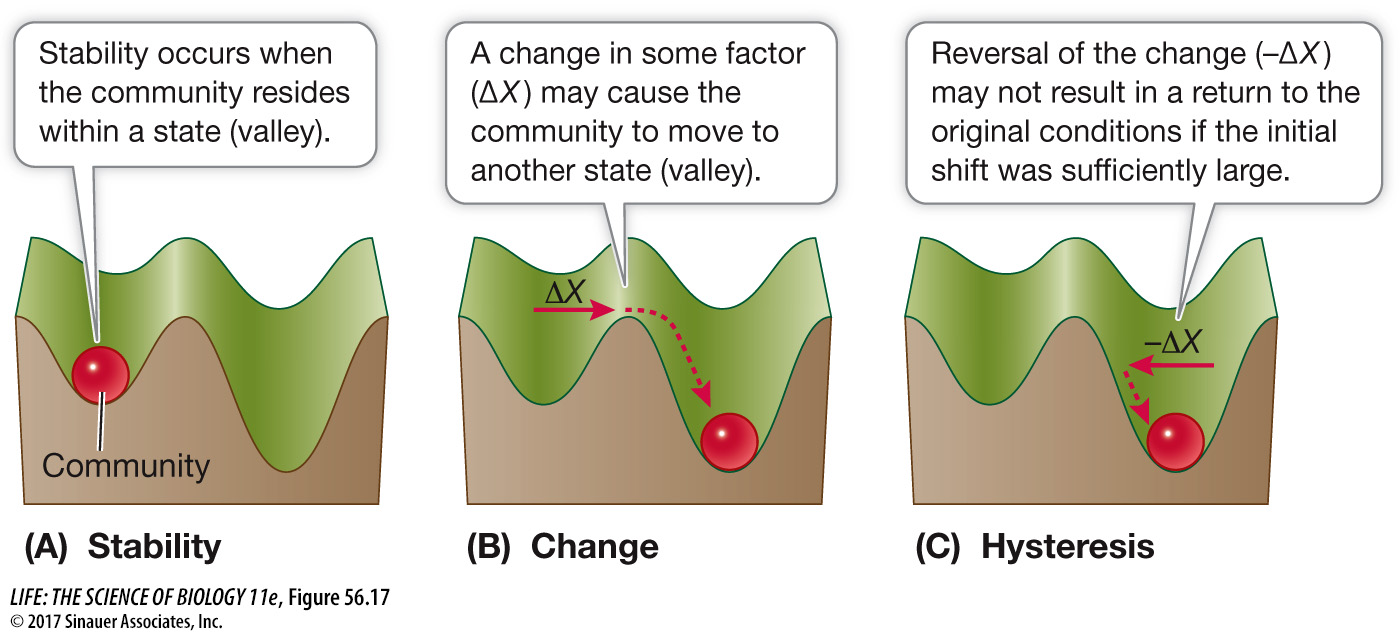Alternative successional pathways result in variations in community composition
The trajectory of succession in any community is not necessarily a repeatable and predictable process. Succession often occurs over long periods of time—longer than the life span of any one researcher—making it hard to know whether the changes in species composition are repeatable over time. For example, suppose dwarf lupines had not successfully colonized the Pumice Plain of Mount St. Helens because of intense herbivory. Might later successional stages, such as growth of Douglas fir forests, never develop? Possibly. What is the chance that different, alternative communities could be established after a similar disturbance? Ecologists use the term alternative states to refer to the different community assemblages that could develop at the same location under similar environmental conditions.
Page 1221
The theory behind alternative states can be visualized by imagining a landscape full of valleys, each of which represents a different community type or state (Figure 56.17A). Imagine, for example, valleys on the Pumice Plain of Mount St. Helens, each of which represents a community that might potentially form there. Impose upon this landscape changes in local conditions—such as the presence or absence of a particularly strongly interacting species—that might influence a community to migrate out of one valley (or state) and into another (Figure 56.17B). Intense grazing by herbivores could, for example, influence where dwarf lupine become established on the Pumice Plain. If lupine does not become established in a “new” valley, a different successional trajectory may be established, leading to an alternative state for the community. Now, what if conditions change again, and revert back to those of the initial state? Interestingly, even if original conditions are restored, the community may not revert to the initial state. If the change experienced by the original community was sufficiently large, the successional trajectory of the community can be irrevocably changed (Figure 56.17C). For example, removing herbivores from the system might not bring back dwarf lupine. The system is said to show hysteresis when the community is unable to shift back to its initial state even when the original conditions are restored.

Figure 56.17 Alternative States (A) A community is represented by a ball that moves within a landscape of community states (valleys). (B) In this analogy the valleys are shallower or deeper according to the magnitude of change (ΔX) needed to shift the community from one state to another. (C) Hysteresis occurs when reversal of the change (–ΔX) does not return the community to its original state.
Communities that have undergone alternative states, or what are sometimes called regime shifts, have become increasingly of interest as it becomes clear that human activities, such as habitat destruction, species introductions, and overharvesting, are shifting communities to alternative states. Once communities have shifted to a new regime it is often unclear whether the original community can be restored or whether hysteresis will occur. Reintroducing wolves to Yellowstone National Park did successfully result in the recolonization of aspens as a consequence of elk population control (see Figure 56.9). But will protection of sea otters populations help reestablish kelp forests? Will Atlantic Ocean and Caribbean coral-reef fish communities recover if lionfish are eradicated there (see Chapter 55, Investigating Life: The Lionfishes King)? These are questions whose answers may be found in better understanding the factors that drive alternative states and the role that restoration plays in reversing the effects of those factors.
